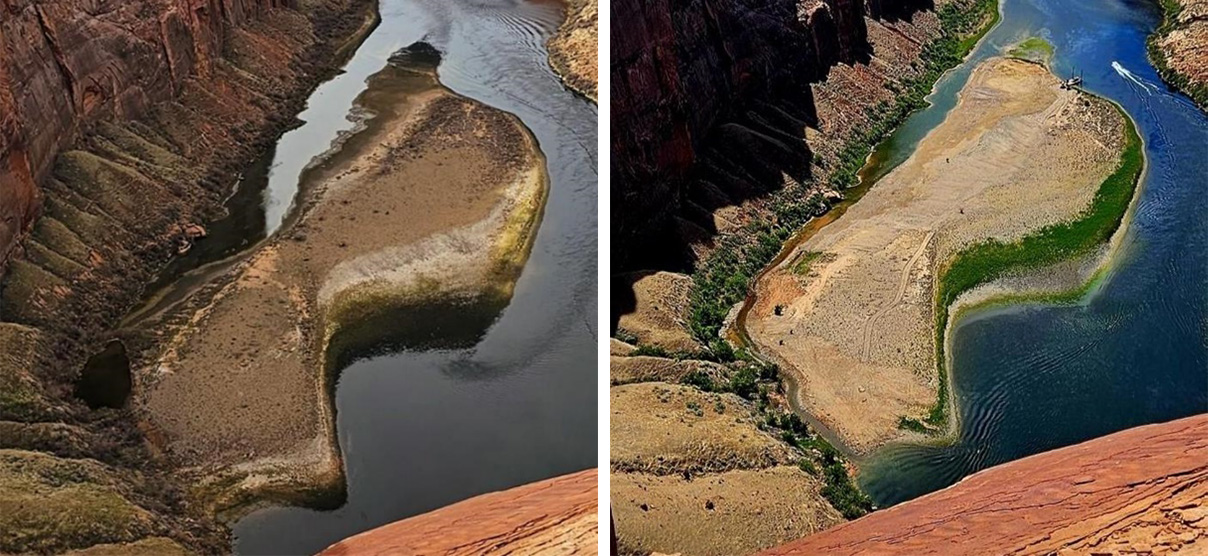News Release

NPS
|
Subscribe
|
Contact: Bureau of Reclamation, Upper Colorado Basin Region
Contact: National Park Service, Glen Canyon National Recreation Area
The Bureau of Reclamation and the National Park Service have completed modifications to a warmwater slough in the Colorado River near Glen Canyon Dam removing a key spawning site for invasive smallmouth bass—a growing threat to native fish.
Located 3.5 river miles downstream from the dam and 12 river miles upstream from Lees Ferry, Arizona, the shallow slough within the Glen Canyon National Recreation Area had become a hotspot for warmwater, nonnative fish due to its elevated temperatures. The project involved reshaping the slough to increase water flow and reduce temperatures, creating unfavorable spawning conditions for smallmouth bass and other invasive species.
“The establishment of warmwater nonnative predatory fish—particularly smallmouth bass—in the Colorado River below Glen Canyon Dam is an imminent threat to the recovery of the humpback chub, a federally protected, threatened species,” said Wayne Pullan, Reclamation Upper Colorado Basin Regional Director. “This channelization effort demonstrates the power of partnerships and adaptive management in protecting the Colorado River ecosystem.”
Before modifications, the slough functioned as a warm backwater to the main river channel, creating ideal spawning habitat for warmwater, nonnative fishes. At the same time, ongoing drought has contributed to the lowering of Lake Powell’s elevation, bringing warmer surface water closer to the dam’s intakes, and increasing the risk of releasing warmwater fish into the Colorado River, where elevated temperatures then support the spread of these invasive species.
Reclamation’s specialized in-house construction team from Provo, Utah, led the modification work, which included removing earth to connect the river’s main channel to the head of the slough and narrowing the lower portion of the slough. This created a channel, rather than a slough, where velocities went from zero to about one foot per second, on average, and allowed for cooler water to flow through thereby discouraging smallmouth bass and other nonnatives from spawning and reestablishing. In response to tribal input, the National Park Service adjusted the design to ensure protection of springs located within the project site. Reclamation managed Glen Canyon Dam flows to allow construction while minimizing environmental impact. Special care was taken to protect native wildlife, particularly salamanders which are rarely seen in the canyon, during the project.
This channelization is part of a larger strategy to curb the establishment of predatory invasive fish that threaten the federally protected humpback chub and other native species in the river. Other efforts include chemical and mechanical removal of nonnative species and the use of “cool mix” flows—pulling colder water from deeper within Lake Powell to cool the river below the dam, creating unfavorable conditions for warmwater fish. Long-term methods to control bass populations below the dam are being explored by both agencies.
“A multi-faceted approach is necessary to address the invasive smallmouth bass and protect native species,” said Jake Ohlson, Acting Superintendent of Glen Canyon National Recreation Area and Rainbow Bridge National Monument for the National Park Service. “The channelization is one component to address the invasion, and other measures will be needed to achieve success.”
The channelization project aims to protect native fish including the threatened humpback chub, endangered razorback sucker, and flannelmouth sucker by limiting smallmouth bass reproduction. The channelization may also benefit the rainbow trout population at Lees Ferry, already observed in the new channel.
Reclamation continues to monitor river temperatures to guide future flow management, while the National Park Service leads ongoing fish monitoring and removal below the dam. The partnership between the two agencies is strong, and the elimination of the slough is evidence that combined efforts can lead to synergistic positive effects to multiple natural resources.
Last updated: June 5, 2025
